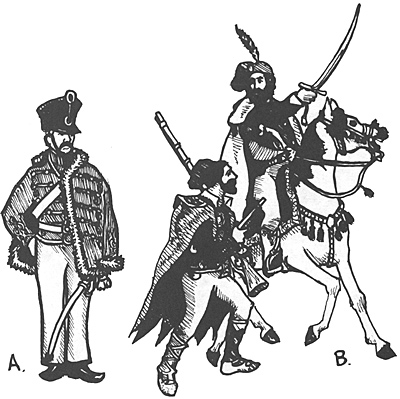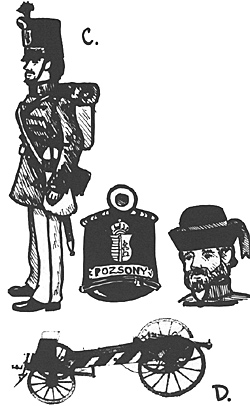The Battle
Having two and a half times more troops, the Ban did not anticipate serious resistance from the Hungarians. On September 28, he issued regular marching orders. He had envisioned encircling the Hungarian right flank and pushing the enemy back into Lake Velence, or at least driving it towards Budapest, forty miles away.
As the battle begun at 8 am, the advance went in piecemeal, from left to right. The Croat left flank commanded by Kempen was the first to come under direct fire. Because the Hungarians were putting up a valiant resistance to his front, he sent two battalions to the rear of the Hungarians along the Lovasbereny road. There were a few local successes, pushing back the Hungarians, mostly thanks to the Sereshan skirmishers. A quick repositioning of a battery and Hungarian Hussars stopped them. Just at this juncture, the Zalai Nation Guard Battalion made it's appearance in Parka, on the Croat's left flank. While the 400 men did not represent a significant threat, their appearance demoralized the Croat militia on that flank and they began to retire south without orders. Kempen was forced to regroup about 1 pm.
The Croats fared even worse in the center. Jellacic attempted to thrust forward with three battalions and part of the cavalry. As with Kempen, the Hungarian Hussar companies and the fire from Holtsch's 24 guns stopped the attack on the center. The artillery fire almost claimed the Ban himself. A cannonball hit one of his adjutants next to him. A militia battalion started to leave the battlefield, and the rest of Schmedl 's Division followed suit. Jellacic was only able to re-deploy Schmedl's troops back at Pakozd.
Because of his lack of officers and aides, Jellacic didn't know what was happening with Kempen. He also had not heard from either Hartlieb or Roth. The first battalions of Hartlieb's division arrived late in the afternoon, only after the Ban had decided against renewing the attack.
The actual casualties were small, about 50 to 100 per side, though some authorities feel it was several times that. The next day Jellacic requested an armistice. He hadn't expected such resistance from the Hungarians. His troops were short of supplies and he had learned that Roth had been turned back at Aba and now was in danger of being cut off. The seemingly miraculous victory at Pakozd was immediately compared the battle that saved France in 1793: Valmy.
Austrian apologists at the time claimed Jellacic had heard about the Vienna unrest and had determined to march in support of the troops there. This explanation doesn't hold up, because the unexpected revolt in the Austrian Capital didn't occur until October 6, a full week after Jellacic had requested a ceasefire. Roth was forced to surrender his entire force at Ozora less than a week later, on October 5th, to Hungarian militia forces, providing the Hungarians with 10,000 badly needed muskets and ammunition. Of course, in keeping with the Hungarians fondness for comparing their struggle to the American Revolution one hundred years before, Ozora was called the Hungarian Saratoga.
 A Few Uniforms
A Few Uniforms
Here are a few of the uniforms that were seen at the battle which were not described in the uniform article in MWAN #120.
A. Banerial Croat Hussars:
Raised by Jellacic in the summer of 1848, they used older Austrian uniforms. The Shako was the black 1836 version, with a slightly bell-like top. All other cording and cockade was regulation. The coat was dark blue with yellow and black cording and trim like the other Austrian Hussar regiments. The overalls were grey, some with black leather inserts from the cuff to mid-calf like most cavalry. The horse furniture was red with yellow borders like the rest of the Austrian cavalry. The flag was a tri-colored swallow-tailed banner. The upper band was red, then white, and the lower band was a medium blue. The flag had gold fringe and a small Croatian coat of arms in the center of the white band. The Banerial regiment met Hungarian Hussars in battle twice. The first encounter was against the 1st Csaszar Hussar Regiment on April 4, 1849. The two commanders fought a traditional duel in front of their troops. Alajos Sebo, the colonel of the 1st Hussars prevailed against the Croat leader, Baron Hermann Riedesel. The Hungarian horsemen then drove the Coats away. The second contest was in June against the 13th Hunyady Hussars. This time the Croat Hussars were routed. Both victories were immortalized in paintings now hanging in the Hungarian War Museum. After the war, the Banerial Hussars became the 13th Austrian Hussar regiment and continued to were the same uniform.
B. The Sereshan
Of course there was a great deal of variety in Sereshan dress, but both foot and cavalry wore a red or black or white cap which looks like a baggy predecessor of the Hussar busby and bag in shape. Like their clothes, there could be a great deal of lace, gold pins, and embroidery on a Sereshan's hat. Officers would wear even more. Coats and capes were red, red-brown or blue. The typical knee pants were dark blue, white or black, though some officers wore red breeches. The stockings were white or tan. Boots were often red or yellow. Most often the native sandals were worn.
White shirts and colorful sashes were worn, and weapons of all kinds were stowed on their person. Colorful feathers, plumes and scarfs were worn. Horse furniture was elaborate and most leather harnesses sported tassels of some kind. Sereshans fought the entire war along the West and Southern borders between Hungary and Croatia in the guerilla actions there, and then with Jellacic's Corps in small numbers. They never were an integral part of the Austrian armies.
 C. The Hungarian National Guard Infantry and Cavalry
C. The Hungarian National Guard Infantry and Cavalry
The basic uniform for the Hungarian National Guard at the beginning of the war was a medium blue long coat with black cording and braid. The pants were generally grey, but sometimes light blue or white with a red stripe down each side. All leather equipment was black, and the backpack brown and fur covered. The Guard usually wore a black belt unlike the Honved battalions. The shako was black for the infantry and red for the cavalry. The shako of both arms sported a large cockade green on the outside, then white with a red center--and some were trimmed with tri-colored cording around the crown. Cavalry had red, white, and green cording for their shakos. The plume was red with a black top. Both infantry and cavalry had white metal clasps and shako plate. The top plate was the Hungarian shield and the bottom the name of the county where the unit was raised. Some infantry battalions had either blue or red kepis, or black, broad-brimmed hats with a red band. Many National Guard units wore an armband of the national colors, red strip on top, white, then green.
The picture shows a typical National Guard uniform from the Trans-Danubian area. The Zalai county units had either the medium blue coat shown or a natural-colored (light tan) coat and pants with no cording. A blue kepi was usually worn. Pesti National Guard battalions wore the natural-colored coat with the grey pants, or they had the coats dyed either black or green. Debreceni units wore a round, black bowler-like hat with a red hatband that hung down the back of the hat. An example is shown at the bottom of picture C. Some of the National Guard units had dark blue coats, such as the Megyei county units. Gyori National Guard units had dark blue cording on the coats instead of black. Gyori artillery coats were dark blue with white cording. The coat had red collar and red pointed cuffs surrounded by the Hungarian knots on the sleeves.
D. Artillery Carriages
From the beginning of the war, Hungarians painted many of their gun carriages with a slantedstriped pattern that looked vertical when the gun was resting on it's trail. The stripes were green, white, and red of course. The majority of the guns were Austrian, so a number stayed the regulation yellow ochre color, but many more were painted with a thin green stain that allowed the yellow to show through, creating a grey-green look. Guns with striped carriages would have the wheels and axes in this grey-green color. The picture is from a gun on display in a St. Petersburg Museum.
The Battle of Pakozd: September 29, 1848 "The Hungarian Valmy"
Back to MWAN # 123 Table of Contents
Back to MWAN List of Issues
Back to MagWeb Magazine List
© Copyright 2003 Hal Thinglum
This article appears in MagWeb.com (Magazine Web) on the Internet World Wide Web.
Other articles from military history and related magazines are available at http://www.magweb.com